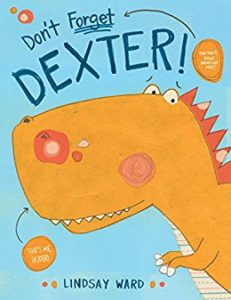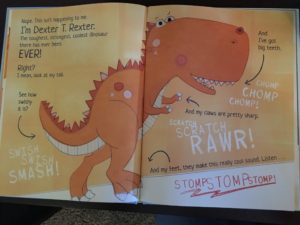 Why I Picked it Up: This is a new book (published last month!) that the publisher was kind enough to send us. Honestly though, I probably would have picked Don’t Forget Dexter! up on one of our weekly trips to the library even if my 4-year-old son’s class wasn’t doing a unit on dinosaurs. My son and I were both drawn to the bright cover and the cute, slightly worried-looking, dinosaur on the cover and my son couldn’t wait to read it with me.
Why I Picked it Up: This is a new book (published last month!) that the publisher was kind enough to send us. Honestly though, I probably would have picked Don’t Forget Dexter! up on one of our weekly trips to the library even if my 4-year-old son’s class wasn’t doing a unit on dinosaurs. My son and I were both drawn to the bright cover and the cute, slightly worried-looking, dinosaur on the cover and my son couldn’t wait to read it with me.
Why I Finished It: I wasn’t exactly sure what to expect, but it was such a fun story! At the beginning of the book, we find our intrepid hero alone and abandoned on the floor. Dexter has lost his friend Jack and is desperately trying to find him. As Dexter waits to be rescued, he becomes less and less confident, feeling like he can’t compete with “cars and trucks and things that go” and fearing that he’s been replaced by honks, beeps and cool sounds. (Spoiler alert: There IS a happy ending!)
I loved Dexter’s voice in this story and the way he seemed to be having a conversation with the reader (it reminded me a bit of Mo Willem’s Pigeon books in that respect). A few times, my son even answered some of Dexter’s questions as I was reading the book!
I also loved the opportunity for conversation created by the fact that, as readers, we’re just getting the toy dinosaur’s perspective. There is so much to talk about in the pictures to fill in the gaps created by a limited narrator. Most kids have gone through the experience of misplacing a favorite toy, so there are also many opportunities to help kids make personal connections to their own lives.
Who I Would Give It To: Don’t Forget Dexter! is a simple, but completely relatable, story for most young kids. I’d recommend it for younger elementary teachers and librarians as it is definitely a great read aloud!
Integration Ideas:
Activating Schema
Before we start reading, before we even look at the book, ask the students if they have a favorite toy or stuffed animal. Let them turn to a neighbor and talk about their toy. Ask the students if they have ever lost that favorite toy and how they felt. Then, ask how they think their toy felt while it was missing.
Retelling
The ability to retell main events, or the order of events, in a story is a foundational skill for younger students that must be solidified in order for them to be able to summarize later on down the road. The simplicity of Don’t Forget Dexter! makes it a great choice for having students practice retelling. They could do this in the traditional way of recalling the events and telling them to a friend.
If you are doing this as a class read aloud, have students decide on the main events in the story as a class. Then write the main ideas on different sentence strips. Give each of the main idea sentence strips to a group of students. Give them time to read (or memorize) their sentence. Then have one person from the group bring the sentence strip to the front and let the class put the groups in order. The students will line up in the order that their events occurred in the story. Then as a class, you can read the main events in order as a retelling of the story.
If you are doing small group activities or literacy center work, students can practice telling the story elements: characters, setting, problem, and solution. I have put ‘placemats’ on the floor with the words character, setting, problem, solution written on them. Then have students step on the ‘placemat’ and answer based on the story provided.
Writing Activity
Don’t Forget Dexter! is a wonderful example of taking a single, simple event and turning it into a story.
Your students can write a personal narrative by explaining a time they lost their favorite toy. After reading the story, have students think about a time when their own favorite animal or toy was lost. Where was it? Have them put themselves in the position of their toy and write a story similar to Dexter’s about how they got lost and (hopefully!) how they were found as well!
Students can also write a procedural paper by either explaining step by step of how to find a lost toy or how to make sure you never lose a toy again!
Don’t forget poetry! Losing a toy, especially a favorite toy, is very traumatic for kids. Have students think of feeling words and emotions associated with how they felt when they realized it was lost as well as how they felt when it was found. Provide students with a poetry form of your choice (suggestion below).
Oh no! I have lost ________________!
I feel ______________________
I think _____________________
I know _____________________
I will _______________________
Hooray, my _____________ is found!
I feel ______________________
I think _____________________
I know _____________________
I will _______________________
Character Sketch with Technology
 At one point in the story, Dexter highlights all his great qualities that make him the “toughest, strongest, coolest dinosaur there has ever been.” Use this opportunity to help even the youngest kids think about character traits. Have the students bring (or bring a picture of) their favorite stuffed animal.
At one point in the story, Dexter highlights all his great qualities that make him the “toughest, strongest, coolest dinosaur there has ever been.” Use this opportunity to help even the youngest kids think about character traits. Have the students bring (or bring a picture of) their favorite stuffed animal.
For students who can read and write, load or take a picture in Skitch. Have the students label the parts of the animal that make them special using the arrows and text (if appropriate).
For pre-readers, use a simple whiteboard app such as Show Me or Educreations to allow students to record their voice as they talk about what makes their animal special. As they talk, they can circle the areas they are talking about.
Literature Connections
- Knufflebunny: A Cautionary Tale by Mo Willems
- The Miraculous Journey of Edward Tulane by Kate DiCamillo
- Article: “Airport Takes Boy’s Lost Stuffed Animal Tiger on ‘Great’ Adventure in Florida”
- Includes links to similar stories from other airports about other animals
Let us know how you plan to use Don’t Forget Dexter in your classroom!






Leave a Reply